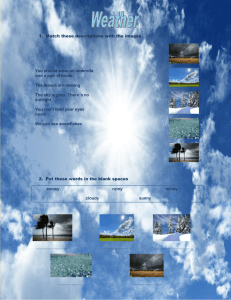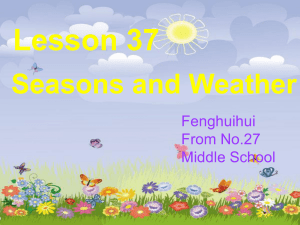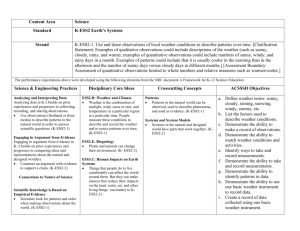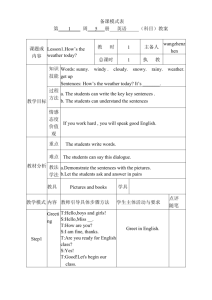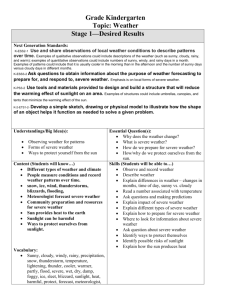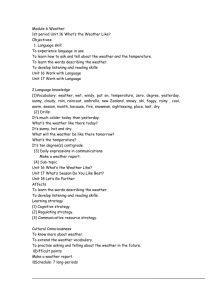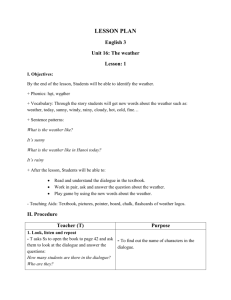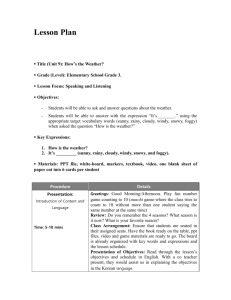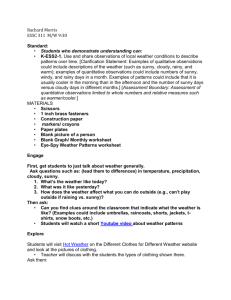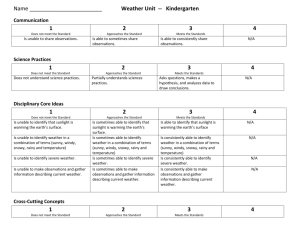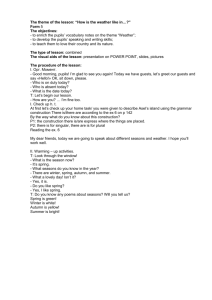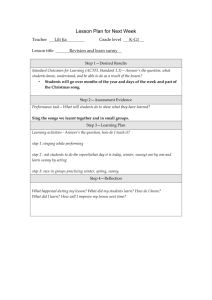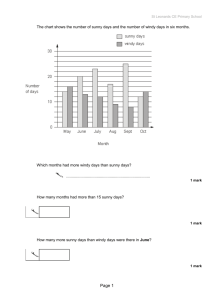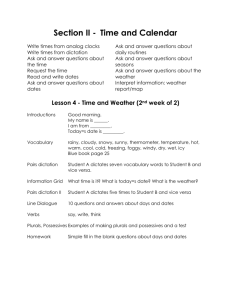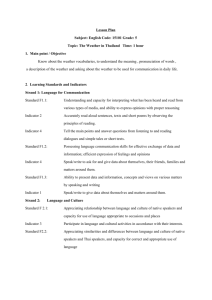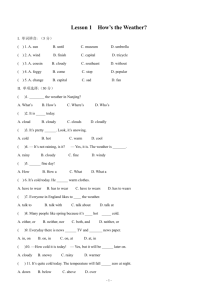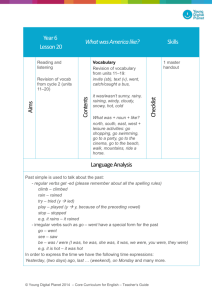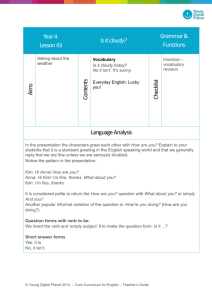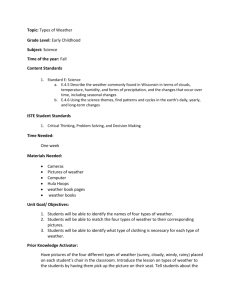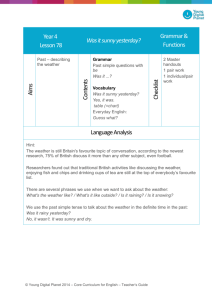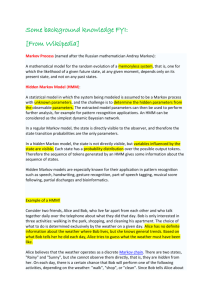Grade 1 Lesson: Types of Weather – Part 1 Reference to English
advertisement
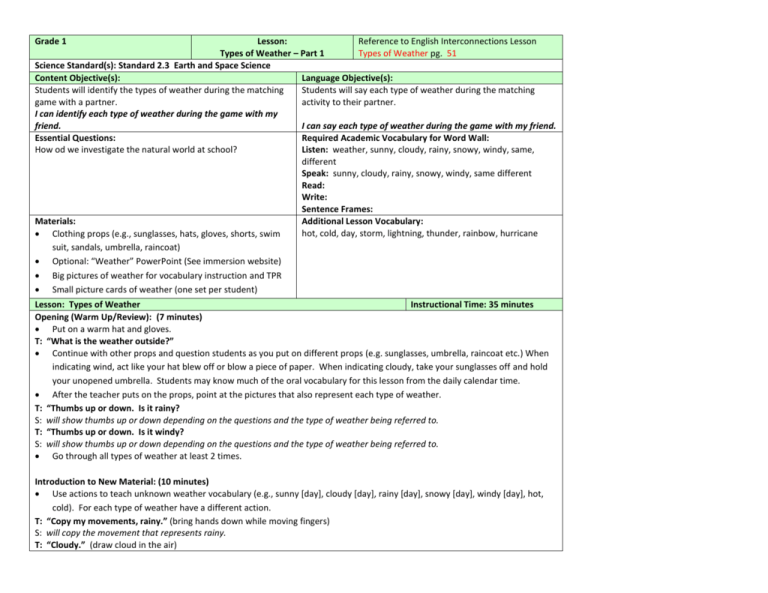
Grade 1 Lesson: Reference to English Interconnections Lesson Types of Weather – Part 1 Types of Weather pg. 51 Science Standard(s): Standard 2.3 Earth and Space Science Content Objective(s): Language Objective(s): Students will identify the types of weather during the matching Students will say each type of weather during the matching game with a partner. activity to their partner. I can identify each type of weather during the game with my friend. I can say each type of weather during the game with my friend. Essential Questions: Required Academic Vocabulary for Word Wall: How od we investigate the natural world at school? Listen: weather, sunny, cloudy, rainy, snowy, windy, same, different Speak: sunny, cloudy, rainy, snowy, windy, same different Read: Write: Sentence Frames: Materials: Additional Lesson Vocabulary: hot, cold, day, storm, lightning, thunder, rainbow, hurricane Clothing props (e.g., sunglasses, hats, gloves, shorts, swim suit, sandals, umbrella, raincoat) Optional: “Weather” PowerPoint (See immersion website) Big pictures of weather for vocabulary instruction and TPR Small picture cards of weather (one set per student) Lesson: Types of Weather Instructional Time: 35 minutes Opening (Warm Up/Review): (7 minutes) Put on a warm hat and gloves. T: “What is the weather outside?” Continue with other props and question students as you put on different props (e.g. sunglasses, umbrella, raincoat etc.) When indicating wind, act like your hat blew off or blow a piece of paper. When indicating cloudy, take your sunglasses off and hold your unopened umbrella. Students may know much of the oral vocabulary for this lesson from the daily calendar time. After the teacher puts on the props, point at the pictures that also represent each type of weather. T: “Thumbs up or down. Is it rainy? S: will show thumbs up or down depending on the questions and the type of weather being referred to. T: “Thumbs up or down. Is it windy? S: will show thumbs up or down depending on the questions and the type of weather being referred to. Go through all types of weather at least 2 times. Introduction to New Material: (10 minutes) Use actions to teach unknown weather vocabulary (e.g., sunny [day], cloudy [day], rainy [day], snowy [day], windy [day], hot, cold). For each type of weather have a different action. T: “Copy my movements, rainy.” (bring hands down while moving fingers) S: will copy the movement that represents rainy. T: “Cloudy.” (draw cloud in the air) S: will copy the movement that represents cloudy. Go through all the types of weather. T: “Now, I am going to make the movement of a type of weather and I want you to shout out what the weather is.” Teacher will make the movements that represent each type of weather. S: will shout out the name of each type of weather that the teacher demonstrates. Guided Practice: (10 minutes) Memory Game Give each student a set of five weather cards. Use the modeling cycle: Teacher Does: Turn over two sets of weather cards (5 each/10 total) on the floor/table/board. Demonstrate how to turn a card over and say the weather it represents and then turn another card over to try to get a match. Model the terms, “your turn, turn over the card, same, not the same” T: “We are going to play a game in groups of 2. Each person will be given 1 set of 5 cards. Let me show you what they look like.” Show the cards 1 at a time and review the weather on each card. T: “What type of weather is on this card?” S: will respond. T: “Good, it is _________. “ T: “Now I am going to put the cards face down on the board” It would be best of you have a magnetic copy to use in front of the students. T: “I need to have two decks of cards, 5 on each side. Now that they are all in place, I am going to choose 2 cards.” Teacher will choose two cards. T: “Are the two cards the SAME or DIFFERENT?” S: will respond “same’ or “different” T: “They are _______ (same or different). This one is __________?” S: will fill in the blank. T: “Yes, this is _________. The other one is ___________?” S: will fill in the blank. T: “Yes, this one is ________. So they are (the) _______ (same or different).” Teacher Does with Student: Call a student up to the front and ask them to turn over two cards. The student should name the picture that they turn over (e.g. sunny, rainy etc.). Next the student should say, “same” or “not the same.” T: “I need a helper. Raise your hand if you want to come up and help me pick two cards.” S: will raise their hands if they want to come up and help. Teacher will pick one student to come up. T: “Please pick 2 cards.” S: will pick two cards. T: “Are they the same or different?” S: will answer, “same” or “different” T: “You are right! They are _______ (same or different). What types of weather are they?” S: will answer with the type of weather on each card. T: “You are right again! Thank you for your help.” Two Students Do: Have two new students come up and take turns turning the cards over and using the appropriate phrases. T: “Now I need two students to come up. You will each get a turn. The first person will pick the card and the second student will ask, ‘What type of weather? Are they the same or different?’” S: Two students will come up and demonstrate how to pick cards and ask questions. T: “Don’t forget to ask, ‘what type of weather is it?’” All Students Practice: Give each child a set of weather picture cards (5 each for sunny, rainy, snowy, cloudy, and windy) and have them pair up with a partner. They should combine their cards (so there are 10), mix them up, and place them face down. T: “Each of you will be given 1 set of 5 cards. You will need to work with 1 friend and play the matching game. You will have 4 minutes. When I clap you will need to clean up.” Separate the class into groups of 2. Walk around as the students are playing the game. This will help them stay on task and you can check if they are doing the activity correctly. Closing: (3 minutes) Bring the students back together. T: “Let’s review! What type of weather is this?” S: will respond. Review each type of weather through props, pictures and movements. T: “What is the weather today?” Mark it on your daily calendar. If appropriate, ask what the weather was in the morning, or afternoon, or yesterday. Tell the students that every day they will talk about the weather. Assessment: Observe if the students can accurately say the weather terms when shown the picture cards during the independent/interactive activity. Extra Ideas: Show a Weather PowerPoint Presentation Weather Cards
